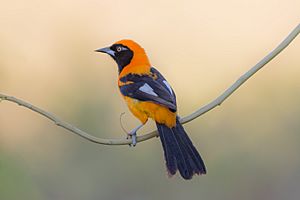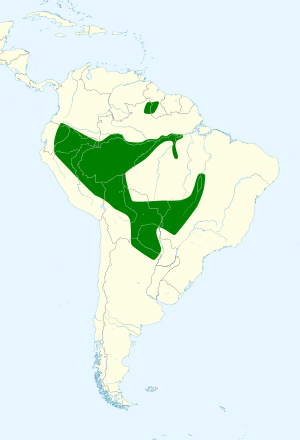Orange-backed troupial facts for kids
Quick facts for kids Orange-backed troupial |
|
|---|---|
 |
|
| An orange-backed troupial in the Pantanal | |
| Conservation status | |
| Scientific classification | |
 |
|
| Where the orange-backed troupial lives |

The orange-backed troupial (Icterus croconotus) is a bright and colorful bird. It belongs to the Icteridae family, which includes orioles and blackbirds.
You can find this bird in parts of South America. Its home includes Guyana, Brazil, Paraguay, and eastern areas of Ecuador, Bolivia, and Peru. It's a close cousin to the Venezuelan troupial and the Campo troupial. Long ago, people even thought they were all the same bird!
Contents
What's in a Name?
The name 'troupial' comes from a French word meaning 'troop'. This is because these birds often live together in groups.
The scientific name Icterus comes from an old Greek word for 'yellow bird'. This name was given to these South American birds because of their bright yellow or orange colors. The second part of its scientific name, croconotus, means "saffron back." Saffron is a bright orange-yellow color.
What Does It Look Like?
The orange-backed troupial grows to be about 23 centimeters (9 inches) long. It is mostly bright orange.
It has a black face, a black bib (like a small shirt front), black wings, and a black tail. There is a small white patch on its wing feathers. You might also see an orange stripe on its shoulder. Around its eye, there is a small blue ring of bare skin.
It's easy to tell it apart from the Venezuelan troupial. The orange-backed troupial has a neat, clean edge to its black bib. The Venezuelan troupial has a more messy bib and a much bigger white patch on its wing.
The song of the orange-backed troupial is loud and musical. It often sings phrases with two syllables.
Where Does It Live?
The orange-backed troupial lives in tropical South America, east of the Andes mountains. It does not migrate, meaning it stays in the same area all year.
Its home stretches from southern Guyana and Colombia. It also lives in eastern Ecuador and Peru. From there, its range goes through eastern and central Brazil, down to Bolivia and northern Paraguay.
These birds like to live at the edges of forests. They can also be found in clearings, along rivers, in younger forests, and in scrubby woodlands. They live in places up to about 750 meters (2,460 feet) high.
Life and Habits
Orange-backed troupials often look for food in pairs. They eat fruits, insects, and other small creatures. They find their food at all levels of the trees. They also drink nectar from wild flowers, like those from the Erythrina tree.
These birds usually breed in July and August in Colombia. In Bolivia and Paraguay, they breed between November and March.
Interestingly, the orange-backed troupial often does not build its own nest. Instead, it sometimes takes over the nest of another bird, like the yellow-rumped cacique.
Conservation Status
This bird lives across a very large area, more than 6 million square kilometers (2.3 million square miles). It is common in some places, but less common in others.
Scientists believe the number of these birds might be slowly going down. This is mainly because of deforestation, which is when forests are cut down in the Amazon rainforest. However, the population is not decreasing fast enough to be in danger. Because of this, the International Union for Conservation of Nature says the orange-backed troupial is a species of "least concern." This means it is not currently at risk of disappearing.
See also
 In Spanish: Turpial amazónico para niños
In Spanish: Turpial amazónico para niños


